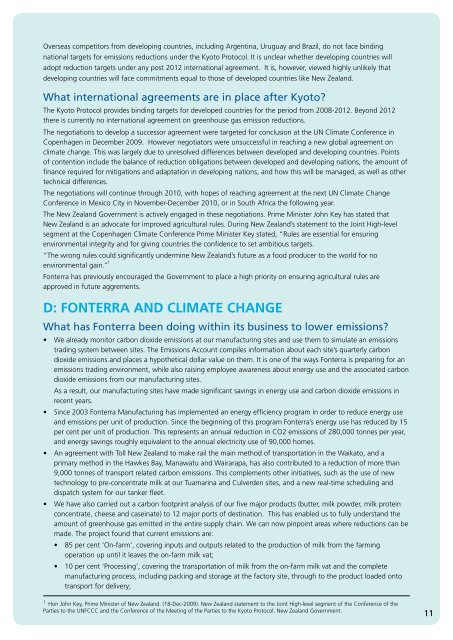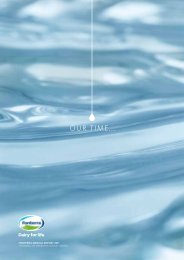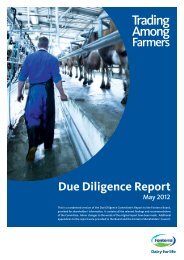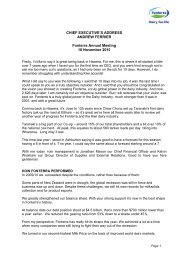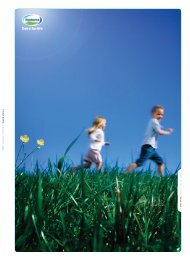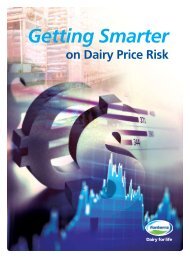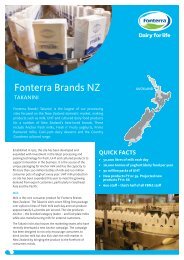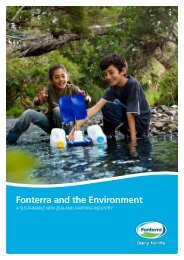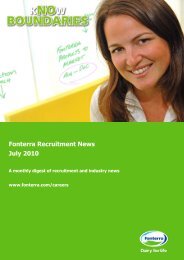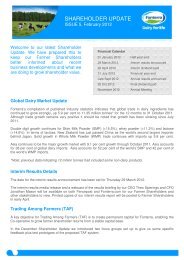A Fonterra Guide to Climate Change
A Fonterra Guide to Climate Change
A Fonterra Guide to Climate Change
- No tags were found...
You also want an ePaper? Increase the reach of your titles
YUMPU automatically turns print PDFs into web optimized ePapers that Google loves.
Overseas competi<strong>to</strong>rs from developing countries, including Argentina, Uruguay and Brazil, do not face bindingnational targets for emissions reductions under the Kyo<strong>to</strong> Pro<strong>to</strong>col. It is unclear whether developing countries willadopt reduction targets under any post 2012 international agreement. It is, however, viewed highly unlikely thatdeveloping countries will face commitments equal <strong>to</strong> those of developed countries like New Zealand.What international agreements are in place after Kyo<strong>to</strong>?The Kyo<strong>to</strong> Pro<strong>to</strong>col provides binding targets for developed countries for the period from 2008-2012. Beyond 2012there is currently no international agreement on greenhouse gas emission reductions.The negotiations <strong>to</strong> develop a successor agreement were targeted for conclusion at the UN <strong>Climate</strong> Conference inCopenhagen in December 2009. However negotia<strong>to</strong>rs were unsuccessful in reaching a new global agreement onclimate change. This was largely due <strong>to</strong> unresolved differences between developed and developing countries. Pointsof contention include the balance of reduction obligations between developed and developing nations, the amount offinance required for mitigations and adaptation in developing nations, and how this will be managed, as well as othertechnical differences.The negotiations will continue through 2010, with hopes of reaching agreement at the next UN <strong>Climate</strong> <strong>Change</strong>Conference in Mexico City in November-December 2010, or in South Africa the following year.The New Zealand Government is actively engaged in these negotiations. Prime Minister John Key has stated thatNew Zealand is an advocate for improved agricultural rules. During New Zealand’s statement <strong>to</strong> the Joint High-levelsegment at the Copenhagen <strong>Climate</strong> Conference Prime Minister Key stated, “Rules are essential for ensuringenvironmental integrity and for giving countries the confidence <strong>to</strong> set ambitious targets.“The wrong rules could significantly undermine New Zealand’s future as a food producer <strong>to</strong> the world for noenvironmental gain.” 1<strong>Fonterra</strong> has previously encouraged the Government <strong>to</strong> place a high priority on ensuring agricultural rules areapproved in future aggrements.D: FONTERRA AND CLIMATE CHANGEWhat has <strong>Fonterra</strong> been doing within its business <strong>to</strong> lower emissions?• We already moni<strong>to</strong>r carbon dioxide emissions at our manufacturing sites and use them <strong>to</strong> simulate an emissionstrading system between sites. The Emissions Account compiles information about each site’s quarterly carbondioxide emissions and places a hypothetical dollar value on them. It is one of the ways <strong>Fonterra</strong> is preparing for anemissions trading environment, while also raising employee awareness about energy use and the associated carbondioxide emissions from our manufacturing sites.As a result, our manufacturing sites have made significant savings in energy use and carbon dioxide emissions inrecent years.• Since 2003 <strong>Fonterra</strong> Manufacturing has implemented an energy efficiency program in order <strong>to</strong> reduce energy useand emissions per unit of production. Since the beginning of this program <strong>Fonterra</strong>’s energy use has reduced by 15per cent per unit of production. This represents an annual reduction in CO2 emissions of 280,000 <strong>to</strong>nnes per year,and energy savings roughly equivalent <strong>to</strong> the annual electricity use of 90,000 homes.• An agreement with Toll New Zealand <strong>to</strong> make rail the main method of transportation in the Waika<strong>to</strong>, and aprimary method in the Hawkes Bay, Manawatu and Wairarapa, has also contributed <strong>to</strong> a reduction of more than9,000 <strong>to</strong>nnes of transport related carbon emissions. This complements other initiatives, such as the use of newtechnology <strong>to</strong> pre-concentrate milk at our Tuamarina and Culverden sites, and a new real-time scheduling anddispatch system for our tanker fleet.• We have also carried out a carbon footprint analysis of our five major products (butter, milk powder, milk proteinconcentrate, cheese and caseinate) <strong>to</strong> 12 major ports of destination. This has enabled us <strong>to</strong> fully understand theamount of greenhouse gas emitted in the entire supply chain. We can now pinpoint areas where reductions can bemade. The project found that current emissions are:• 85 per cent ‘On-farm’, covering inputs and outputs related <strong>to</strong> the production of milk from the farmingoperation up until it leaves the on-farm milk vat;• 10 per cent ‘Processing’, covering the transportation of milk from the on-farm milk vat and the completemanufacturing process, including packing and s<strong>to</strong>rage at the fac<strong>to</strong>ry site, through <strong>to</strong> the product loaded on<strong>to</strong>transport for delivery;1. Hon John Key, Prime Minister of New Zealand. (18-Dec-2009). New Zealand statement <strong>to</strong> the Joint High-level segment of the Conference of theParties <strong>to</strong> the UNFCCC and the Conference of the Meeting of the Parties <strong>to</strong> the Kyo<strong>to</strong> Pro<strong>to</strong>col. New Zealand Government.11


